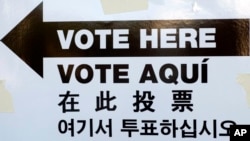The number of people in counties requiring elections officials to provide voting materials in languages other than English jumped by almost a quarter over the past five years, reflecting the increasingly diverse electorate in the U.S., according to figures released Wednesday by the Census Bureau.
More than 24.2 million people live in 331 counties and other jurisdictions requiring language assistance under the federal Voting Rights Act, a jump from 19.8 million in 2016, the last time the list was updated.
The law requires the jurisdictions to provide language assistance to voters if more than 5% of voting-age citizens come from a single-language minority group and they don't speak English sufficiently to participate in the electoral process. Jurisdictions also fall into the category if more than 10,000 voting-age citizens speak a single language other than English and the rate of people who haven't completed fifth grade is higher than the national rate.
The overwhelming majority of residents in these jurisdictions require Spanish language assistance. Among the other languages in which voting materials are required, depending on the jurisdiction, are Cambodian, Chinese, Filipino, Hindi, Korean, Vietnamese, as well as several American Indian and Alaskan Native languages.
Three states — California, Florida and Texas — are under the requirement, though counties in these states can opt out if they are below the 5% threshold.
The new list reflects the increasing diversity of some U.S counties and other jurisdictions.
Prince George's County, Maryland, a majority-Black county outside Washington, was added to the list because of its growing Hispanic community. Minnesota didn't have any counties on the list in 2016, but two Minnesota counties were included in 2021 — Ramsey County with a Hmong language requirement and Houston County to account for its American Indian population. In Philadelphia, officials already were required to provide language assistance for the Hispanic community but now must also do the same for the Chinese population.
Data from the Census Bureau's American Community Survey was used to compile the list.




